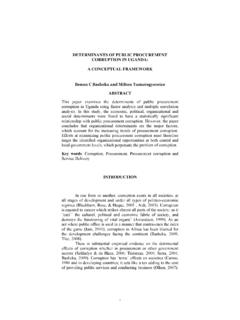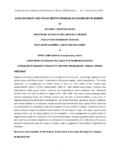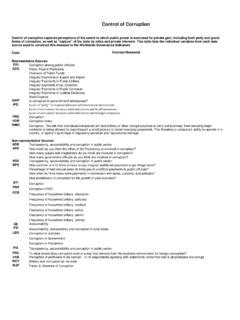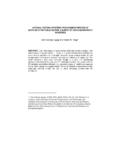Transcription of Curbing Fraud, Corruption, and Collusion in the Roads Sector
1 Curbing fraud , corruption , and Collusion in the Roads Sector The World BankIntegrity Vice PresidencyTHE WORLD BANK1818 H Street, , DC 20433 Curbing fraud , corruption , and Collusion in the Roads Sector The World BankIntegrity Vice PresidencyJune 20112011 The International Bank for Reconstruction and Development/The World Bank Integrity Vice PresidencyThe World Bank GroupMSN U11-1100 Washington DC 20433 rights reservedThe findings, interpretation and conclusions expressed here are those of the author (s) and do not necessarily reflect the views of the Board of Executive Directors of the World Bank or the governments they represent. The World Bank cannot guarantee the accuracy of the data included in this work. Rights and PermissionsThe material in this work is copyrighted.
2 Copying and/or transmitting portions or all of this work without permis-sion may be a violation of applicable law. The World Bank encourages dissemination f its work and will normally grant permission promptly. For permission to photocopy or reprint any part of this work, please send a request with complete information to the Integrity Vice Presidency at the address stated vFoReWoRd viiexeCuTive SummARy ixi. inTRoduCTion 1 Development Impact of Roads 1ii. WoRld BAnk inveSTigATive FindingS 5iii. Collusion in RoAd TendeRS 11A. Evidence from Non-Bank Projects 12B. Cartel Theory 12C. Developed Country Experience 13D. Effect of Collusion on Tender Prices 13iv. fraud And corruption in ConTRACT implemenTATion 17v. ComBATing Collusion , fraud , And corruption 19A.
3 Measures to Reduce Collusion 19 Punish cartelization severely 19 Create incentives for the exposure of cartels 20 Revise tendering rules 20 Require independent bid certificates 23 Retain an independent procurement evaluator 23B. Measures to Reduce fraud and corruption 24 Strengthen the engineer 24 Hire a technical auditor 25 Engage civil society monitors 26 Develop accurate cost estimates 26 Check the wealth of key procurement agency officials 26C. Longer-Term Capacity-Building Measures 27 Modernize the Roads Sector agency 27 Strengthen competition law enforcement 27 Curbing fraud , corruption , and Collusion in the Roads SectorivD. Experimental Measures 27 Impose ceiling on bids 28 Use competitive negotiation 28 Contract out procurement 28E.
4 Issues for Consideration by Bank Operations Staff 29 Trade-offs between Transparency and Collusion 30 Subcontracting as a facilitator of capacity-building and Collusion 30 Customizing measures to address fraud and corruption in civil works contracts 30 Developing expertise on cost estimating and detecting collusive bidding 30 Reevaluate current contract management form 31 Target enforcement on engineering firms 32 Increase contingent of professional World Bank staff with road engineering expertise 32 Spend more on corruption prevention in projects 32vi. ConCluSion 35 ReFeRenCeS 37 Annex 1: pRoving Bid Rigging on Roads TendeRS 45 Annex 2: ReFoRmS To puBliC pRoCuRemenT in oeCd CounTRieS 47 TablesTable 1.
5 Misconduct Cases in World Bank Roads Projects: Sanctions Imposed 6 Table 2. Misconduct Cases in World Bank Roads Projects: Sanctions Pending or Not Sought 7 Table 3. Estimated Cartel Overcharges 14 Table 4. Results of Audit of Zambian Roads Projects 17 BoxesBox 1. World Bank Definitions of Misconduct 2 Box 2. Collusion and Cartels 8 Box 3. Ten Indicators of Collusive Bidding 12 Box 4. Publishing Cost Estimates: the Trade off Between Transparency & Collusion 21 Box 5. Combating Collusion by Changing the Procurement Process 22 Box 6. Certificate of Independent Price Determination 24 Box 7. Using Competitive Negotiation to Circumvent a Cartel: the US Experience 29 Box 8. Reducing fraud and corruption in Civil Works 31 AcknowledgmentsThis report was authored by Richard Messick (INT) un-der the direction of Leonard McCarthy, Vice President, INT, and Galina Mikhlin-Oliver, Director for Strategy and Core Services, INT.
6 Valuable inputs were pro-vided by Anders Agerskov with support from Virginia Fatourou-Papanikolaou, Alba Struga, and Athene A. Vila-Boteler of INT s Preventive Services comments and contributions were provided by colleagues across INT, including in particular Stephen Zimmerman (INTOP), Jonathan Shapiro (INTOP), Simon Robertson (INTOP), Leonard Newmark (INTOP), Susan Hume (INTSC), Annie Yau (INTSC), and David Bernstein (INTSC), and numerous col-leagues in SDN, OPCS, the regions, LEG, and GSD, including Marc Juhel (TWITR), Gouthami Padam (TWITR), Hudayberdi Ahmedov (TWITR), Paul Bermingham (OPCOS), Bernard Becq (OPCPR), Maria Vannari (OPCPR), Moses Wasike (OPCFM), Richard A. Calkins (Consultant), Jack Titsworth (OPCFM), Pat Rogers (OPCCS), Charles Kenny (Center for Global Development), Luc Lecuit (EACTF), Carolina Monsalve (ECSS5), Bill Patterson (Consultant), Ga l Raballand (AFTPR), Donald Mphande (AFTFM), Tina Soreide (U4), Steve Burgess (EAPCO), Joel Turkewitz (EAPVP), Ahsan Ali (EAPPR), Cecilia D.
7 Vales (EAPPR), Therese Ballard (GSDPR), Antonio Capobianco (OECD), Ben Geiricke (ECSSD), Frank Fariello (LEGOP), Rowena M. Gorospe (LEGOP), Laurence Folliot Lalliot (LEGOP), and Aneta K. Wierzynska (Consultant).Simon Robertson/World BankForewordFrom earliest times one of the strongest indicators of a society s development has been its road infrastructure, or lack thereof. At its height, the Roman Empire reput-edly built the best engineered and most complex road network worldwide. The Old Testament also contains references to the ancient King s Highway. Corduroy Roads were built in Glastonbury, England in 3300 BC with street paving going back to early human settlement around 4000 BC in the Indus Valley on the Indian sub-continent.
8 Our history speaks planned, properly maintained, and safe Roads are critical for economic growth and overcoming poverty in developing countries. The Roads Sector has been a major target for development financing over the entire history of the World Bank and remains important today. Between 2000 and 2010, the World Bank committed close to $56 billion for road construction and mainte-nance and expects to continue its active support for the Roads Sector in its client countries for years to Roads projects supported by the World Bank Group have had consistently positive development re-sults, dangers of fraud , corruption , and Collusion plague the Sector worldwide. Though this is a problem for both developed and developing countries it is much more costly in terms of opportunity costs and lost economic growth for developing countries.
9 Given the importance of Roads to the poor, this challenge is of special signifi-cance to the World help our clients safeguard their Roads projects from fraud , corruption , and Collusion , the World Bank must be innovative and learn more systematically from our experiences and those of our development partners and client countries. This report of the Preventive Services Unit of the World Bank s Integrity Vice Presidency (INT) supports this effort by turning both the results of INT s investigations and the experiences of developed and developing countries into practical advice about a range of measures in order to stem Collusion in tenders for Roads contracts, and fraud and corruption in con-tract said, We can t solve problems by using the same kind of thinking we used when we created them.
10 So we need to revisit past practices, drawing on the knowledge of those on the ground in client report recognizes that conditions across borrowing countries differ significantly, as they do in developed countries, and that what works in one country may not in another. The measures we offer are not panaceas, or cookbook solutions. Diagnoses of the nature of the problems are important in devising possible solutions. Our aim is to spur dialogue among all stakeholders on how to improve the way the World Bank and its clients do business in the Roads bad news is that ensuring the integrity of Roads projects is a challenge for many developed and devel-oping countries since fraud , corruption and Collusion historically prove resistant to easy treatment or simple solutions.















